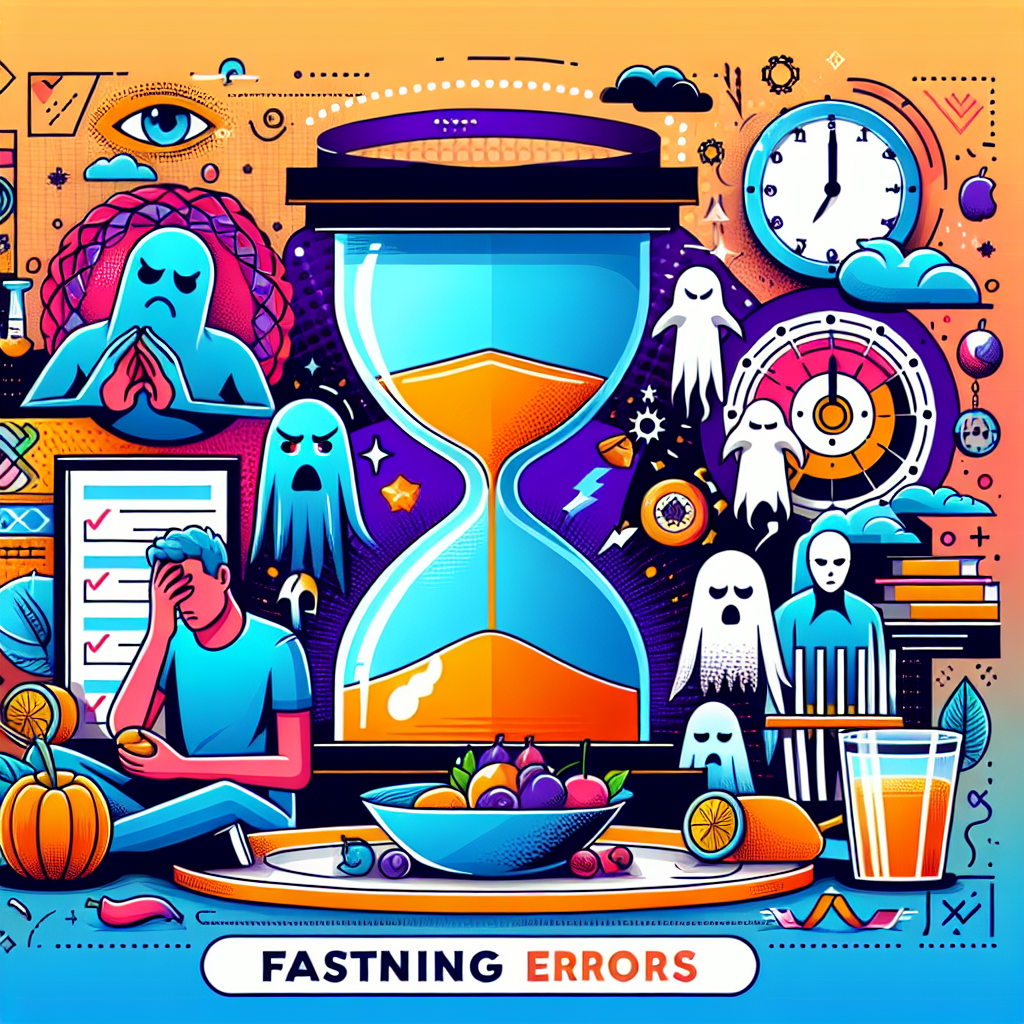
Unlocking the Power of Fasting for Health and Wellness
Fasting has become one of the most popular tools for enhancing overall wellness, gaining traction within scientific research and among health-conscious individuals alike. Whether you’re exploring a time-restricted eating plan for weight management or intermittent fasting to support metabolic health, the benefits can be impressive. According to research from the New England Journal of Medicine, intermittent fasting can help regulate blood sugar, reduce inflammation, and may even support longevity (de Cabo & Mattson, 2019).
However, many people experience plateaus or even setbacks. The culprit? Often, it’s not the method itself—but how it’s being used.
To help you get the results you’re working hard to achieve, here are the most common fasting mistakes—and what to do instead.
Mistake 1: Overeating During Your Feeding Window
One of the most widespread misconceptions is that you can eat anything you want during your feeding window without consequences. Unfortunately, filling that window with high-calorie, processed foods and oversized portions can easily undo your fasting efforts.
A 2020 study in Cell Metabolism revealed that participants who avoided processed foods and prioritized nutrient-dense meals experienced significantly better metabolic outcomes, even when following the same fasting protocol.
When using intermittent fasting for fat loss, pairing your eating window with balanced, portion-controlled meals is critical.
Dr. Jason Fung, author of The Complete Guide to Fasting, emphasizes, “Your feeding window is not a free-for-all. The quality and amount of food consumed still play a major role in your results.”
Solution: Use a food tracking app for one week to assess your intake. Focus on whole foods like grilled chicken, salmon, quinoa, leafy greens, avocado, and nuts. Use a visual guide (like the size of your hand) for sensible portions without the stress of calorie counting.
Mistake 2: Inconsistent Fasting Schedules
Inconsistency is a hidden saboteur. One day you fast for 14 hours, the next for 19, and on weekends, you skip altogether. While flexibility is one of fasting’s advantages, too much variation can confuse your body’s internal clock.
Dr. Satchin Panda, a leading expert in circadian rhythms, notes, “Our biological rhythms thrive on consistency. Irregular eating patterns can disrupt digestion, hormones, and fat metabolism.”
A Healthline survey uncovered that nearly 60 percent of people practicing intermittent fasting reported having fluctuating fasting times, which significantly hampered their progress.
A consistent intermittent fasting schedule helps regulate hormones, boost insulin sensitivity, and promote efficient fat-burning.
Solution: Choose a protocol that fits your lifestyle—such as 16:8 or 18:6—and stick to it at least five days a week, including weekends. Use calendar reminders or meal scheduling tools to maintain structure and enhance success.
Mistake 3: Breaking Your Fast With Unhealthy Foods
After fasting, your body is highly receptive to nutrients. But if your first meal includes sugary pastries or processed snacks, you could experience a steep blood sugar spike followed by an energy crash.
For instance, starting your day with a donut and sugary coffee might feel satisfying temporarily—but likely leaves you tired and hungry shortly after.
Registered dietitian Keri Glassman explains, “When you break your fast with whole, nutrient-rich foods, it stabilizes blood sugar and curbs appetite throughout the day.”
The best foods to break a fast include lean proteins, fiber-rich vegetables, and healthy fats.
Solution: Choose meals such as:
– Scrambled eggs with avocado and sautéed spinach
– Greek yogurt topped with berries and chia seeds
– A smoothie with banana, kale, protein powder, and almond butter
Mistake 4: Neglecting Hydration and Electrolyte Balance
Fasting naturally lowers insulin levels, causing your body to release more sodium and fluids. Without replenishing these, you might deal with fatigue, brain fog, or even symptoms similar to the “keto flu.”
Research has shown that during a 24-hour fast, people may excrete up to 1.5 liters more water than on eating days (Finney et al., 2016).
Proper hydration while fasting is a must for maintaining energy and avoiding common side effects.
Solution: Aim to drink 8 to 10 cups of water daily. Replenish electrolytes using a pinch of Himalayan salt, a sugar-free electrolyte powder, or magnesium supplements. For hydration essentials, edrugstore.com offers a curated selection of support tools.
Mistake 5: Overexerting With Intense Workouts While Fasting
While fasted cardio can support fat burning, going all-out with strength training or high-intensity workouts during a fast may lead to burnout, especially for beginners.
Fitness coach Ben Carpenter warns, “Overtraining on an empty stomach can elevate cortisol and contribute to muscle breakdown.”
For high-intensity exercise during intermittent fasting, it’s important to fuel your body strategically.
Solution: Schedule tough workouts right before your eating window. This allows for optimal post-exercise recovery. If your workout falls in the middle of a fast, consider a light snack—like a few almonds or a protein shake—beforehand, followed by a balanced meal soon after.
Mistake 6: Being Obsessed With the Clock
If you’re constantly checking the time, counting minutes until your eating window opens, your fasting routine may be causing unnecessary stress.
Dr. Nicole LePera, a clinical psychologist, explains, “Fasting should help you feel free, not trapped. If you’re anxious about the clock, you may be doing more harm than good.”
Create a flexible intermittent fasting routine that honors your body’s hunger cues rather than rigid timeframes.
Solution: Treat fasting as a guide—not a mandate. If genuine hunger sets in 20 to 30 minutes before your scheduled eating window, it’s okay to listen to your body. Emotional and physical well-being should remain the top priority.
Mistake 7: Overlooking Sleep and Stress
Even the best fasting regimen can be derailed by poor sleep and unmanaged stress. These factors wreak havoc on hormones that control appetite and metabolism, including cortisol, ghrelin, and leptin.
A comprehensive analysis in Obesity Reviews found that sleep-deprived individuals consumed an average of 385 more calories per day (Benedict et al., 2013).
Optimal intermittent fasting success is closely tied to adequate sleep and stress management.
Solution: Aim for 7 to 9 hours of restful sleep. Wind down with calming activities like herbal tea, journaling, or meditative music. Incorporate relaxation techniques, such as deep breathing or guided meditations, into your daily routine. For supplements that support stress relief and sleep—such as magnesium or melatonin—edrugstore.com provides several effective options.
Final Thoughts: How to Make Fasting Work for You
Fasting isn’t a miracle fix—it’s a powerful tool that thrives on smart, sustainable strategies. Even though scientific evidence supports its benefits, your daily habits ultimately determine your success.
Avoiding common intermittent fasting mistakes—like overeating, being inconsistent, choosing poor-quality foods, skipping hydration, overexerting during workouts, stressing over time, and neglecting sleep—can vastly improve your results.
For long-lasting success, combine strategic intermittent fasting with clean nutrition, regular movement, quality sleep, and proper hydration.
By fine-tuning your approach and integrating these simple tweaks, you’ll not only make fasting more effective—but also more enjoyable.
Resources
– de Cabo, R., & Mattson, M. P. (2019). Effects of intermittent fasting on health, aging, and disease. New England Journal of Medicine, 381(26), 2541–2551.
– Finney, S. J., et al. (2016). The physiology of fasting. Annual Reviews in Nutrition, 36, 171–191.
– Benedict, C., et al. (2013). Acute sleep deprivation increases food intake in healthy men. Obesity Reviews, 14(8), 707–715.
For trusted fasting supplements, hydration aids, and wellness tools, visit edrugstore.com.


